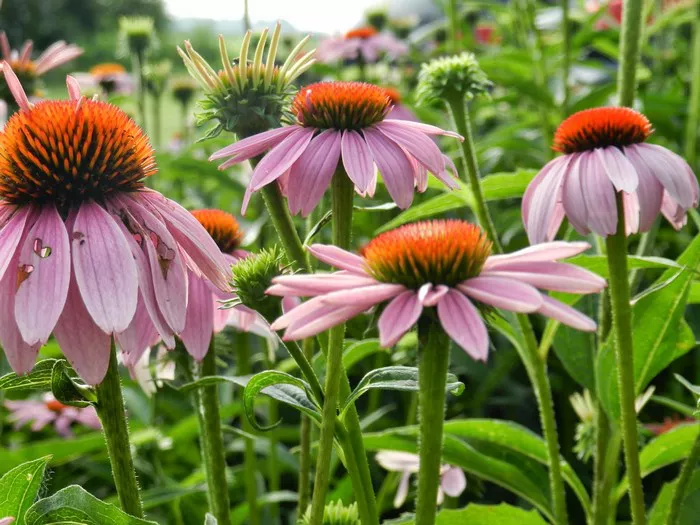Coneflowers, particularly those of the Echinacea genus, have long been cherished for their vibrant blooms, medicinal properties, and ability to attract pollinators. Gardeners and enthusiasts often wonder about the lifespan of these hardy perennials. In this article, we delve into the factors influencing the longevity of coneflowers and provide insights into maximizing their lifespan in your garden.
Understanding Coneflowers: An Introduction to Echinacea
Before delving into the lifespan of coneflowers, it’s essential to understand the plant itself. Echinacea, commonly known as coneflower, belongs to the Asteraceae family and encompasses several species native to North America. These striking perennials are renowned for their daisy-like blooms, which feature prominent, cone-shaped centers surrounded by colorful petals. Among the most popular species are Echinacea purpurea, Echinacea angustifolia, and Echinacea pallida.
Aside from their ornamental value, coneflowers have a rich history of medicinal use, particularly among Indigenous communities, who utilized various parts of the plant to treat ailments ranging from colds to snakebites. Today, echinacea extracts and supplements are widely marketed for their purported immune-boosting properties.
Factors Influencing Lifespan
The lifespan of coneflowers can vary depending on a multitude of factors, both environmental and cultural. Understanding these influences is crucial for ensuring the longevity of your plants. Here are some key factors to consider:
1. Species and Variety: Different species and cultivars of coneflowers may exhibit varying lifespans. Some species, such as Echinacea purpurea, are known for their longevity and adaptability, while others may have shorter lifespans or specific environmental requirements.
2. Growing Conditions: Adequate growing conditions are essential for the health and longevity of coneflowers. These plants thrive in well-draining soil with sufficient organic matter and prefer full sun to partial shade. Providing optimal conditions will help minimize stress and increase longevity.
3. Watering: Coneflowers are drought-tolerant once established, but consistent moisture is crucial, especially during the establishment phase. Avoid overwatering, as excessively wet soil can lead to root rot and other diseases that can shorten the lifespan of the plant.
4. Temperature and Climate: Coneflowers are generally hardy in USDA zones 3-9, depending on the species. Extreme temperatures, particularly prolonged periods of heat or cold, can stress the plants and affect their longevity. Choosing species or cultivars suited to your climate zone can help mitigate these risks.
5. Pests and Diseases: Like any plant, coneflowers are susceptible to pests and diseases that can impact their health and lifespan. Common pests include aphids, spider mites, and Japanese beetles, while fungal diseases such as powdery mildew and aster yellows can also pose threats. Proper sanitation and vigilance can help prevent infestations and diseases.
6. Maintenance Practices: Regular maintenance, including deadheading spent blooms, dividing overcrowded clumps, and removing diseased or damaged foliage, can promote the health and longevity of coneflowers. Additionally, fertilizing sparingly with a balanced fertilizer can provide the nutrients necessary for vigorous growth.
7. Companion Planting: Companion planting coneflowers with compatible species can provide benefits such as pest control, improved soil fertility, and enhanced biodiversity, ultimately contributing to the overall health and longevity of the garden ecosystem.
Lifespan of Coneflowers: How Long Can They Live?
Now, the burning question: How long do coneflowers actually live? While there is no one-size-fits-all answer, as lifespan can vary depending on the factors mentioned above, coneflowers are generally considered long-lived perennials. Under optimal growing conditions and with proper care, they can persist in the garden for several years, often reaching five to ten years or more.
Echinacea purpurea, one of the most commonly cultivated species, is known for its longevity and can live for a decade or longer with proper care. However, it’s essential to note that individual plants within a population may exhibit differences in vigor and lifespan, influenced by genetics, environmental conditions, and cultural practices.
In some cases, coneflowers may self-sow and naturalize in the garden, forming colonies over time. While this can contribute to the overall longevity of the species in a particular area, it’s important to monitor and manage self-sowing to prevent overcrowding and maintain a balanced ecosystem.
Tips for Maximizing Lifespan
To ensure your coneflowers thrive and reach their full potential lifespan, consider implementing the following tips:
1. Choose the Right Species and Cultivars: Select species and cultivars suited to your climate and growing conditions for optimal performance and longevity.
2. Provide Adequate Care: Maintain consistent moisture, provide proper drainage, and ensure sufficient sunlight to promote healthy growth and longevity.
3. Monitor for Pests and Diseases: Regularly inspect plants for signs of pests or diseases and take appropriate measures to control infestations and minimize damage.
4. Practice Good Garden Hygiene: Remove spent blooms, dead foliage, and weeds to reduce competition for resources and prevent the spread of diseases.
5. Divide Overcrowded Clumps: Periodically divide congested clumps of coneflowers to rejuvenate plants, improve airflow, and prevent overcrowding.
6. Avoid Overfertilization: Apply fertilizers sparingly and avoid overfertilization, as excessive nutrients can lead to lush but weak growth, making plants more susceptible to pests and diseases.
7. Promote Biodiversity: Companion plant coneflowers with compatible species to enhance biodiversity, attract beneficial insects, and create a resilient garden ecosystem.
Conclusion
By following these guidelines and understanding the factors influencing the lifespan of coneflowers, you can enjoy the beauty and benefits of these remarkable perennials for years to come. With proper care and attention, your coneflower garden can thrive and evolve, enriching your outdoor space and providing joy season after season.


